Get ready to be dazzled by the brilliance of STEM learning, a realm that thrives in the pulse of modernity. In this age of boundless possibilities, a solid foundation in science, technology, engineering, and math emerges as an indispensable necessity. But fear not, for the journey towards STEM prowess is far from mundane. Prepare to immerse your young learners in a symphony of hands-on activities, where innovation and real-world applications take center stage.
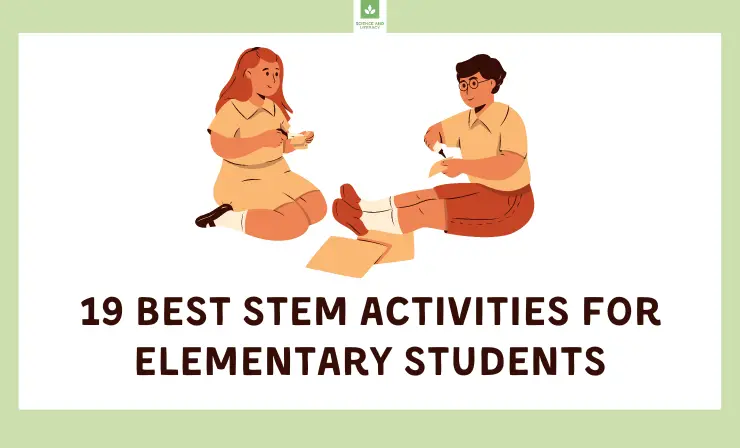
As young minds grapple with these stimulating endeavors, they shall traverse the interwoven landscapes of science, technology, engineering, and math, witnessing the transformation of theory into tangible feats. So, get ready to witness the wonders that unfold as STEM learning takes flight, empowering a generation with the tools to embrace the future, where innovation and creativity collide to shape a world brimming with possibilities.
Here’s how other teachers include use STEM activities in the education process:
Another thing I like about purposeful, engaging #STEM activities – they are contagious! 🔥When one group experiences integration, others want to as well! 4th graders learned the importance of armor and other animal adaptations today. The APEX predator was well armed (green one)! pic.twitter.com/rmvU0D8Goc
— Kim Collazo (@kcollazo) May 11, 2022
So, the 19 best STEM activities for elementary students are:
| STEM activity | Difficulty level | Cost | What does it teach |
| 1. Crystal Sun Catchers | Low | Low | Introduces crystal growth and its connection to art while creating beautiful sun catchers. |
| 2. Jellybean Building | Low | Low | Sparks creativity in structural engineering, promoting problem-solving and design skills. |
| 3. Pipe Cleaner Counting | Low | Low | Provides a hands-on and visual approach to understanding counting and numerical progression. |
| 4. Testing Air Resistance with Parachuts | Low | Low | Teaches how air resistance impacts the motion of objects in the air. |
| 5. Longest Paper Chain | Low | Low | Promotes critical thinking, spatial reasoning, and problem-solving skills as students explore how to maximize the length of the paper chain within given constraints. |
| 6. Cloud in a Jar | Low to Medium | Low | Demonstrates condensation and the water cycle. |
| 7. Oil Spill | Low to Medium | Low | Raises awareness about the environmental impact of oil spills and the importance of conservation. |
| 8. LEGO Maze Coding | Low to Medium | Low | Teaches basics of coding and programming, computational thinking, robotics, and engineering concepts. |
| 9. Hand Crank Winch | Low to Medium | Low | Explores simple machines and mechanical principles while engaging in hands-on construction. |
| 10. Balance Scale | Low to Medium | Low | Encourages experimentation with weights and measurements, fostering critical thinking. |
| 11. Stop-Motion Animation Video | Low to Medium | Low | Offers a creative and technologically engaging activity to explore animation and movie-making, fostering storytelling and technology utilization. |
| 12. Drinking Straw Roller Coaster | Low to Medium | Low | Teaches engineering principles, including structural stability and the dynamics of motion. |
| 13. Marble Maze | Low to Medium | Low to Medium | Encourages creativity, critical thinking, and understanding of physics concepts like gravity, friction, and motion. |
| 14. Magnetic Slime | Medium | Low | Introduces magnetism and properties of polymers through a fun, hands-on experiment. |
| 15. Solar Oven Project | Medium | Low | Demonstrates solar energy principles and sustainable cooking methods. |
| 16. Egg Drop Challenge | Medium | Low | Teaches engineering and problem-solving skills as students design protective containers for eggs. |
| 17. Balloon-Powered Car | Medium | Low | Teaches the principles of motion and propulsion, introducing concepts like Newton’s third law of motion. |
| 18. Steady-Hand Game | Medium | Medium | Introduces students to circuitry and electrical components while honing their fine motor skills and problem-solving abilities. |
| 19. Helping Hand | Medium to High | Low | Inspires critical thinking and problem-solving while exploring biomechanics and engineering in creating a functional hand model. |
These STEM activities, a gateway to cool discoveries, challenge young minds to unravel the intricacies of everyday life. Behold, for within these challenges lies the power to awaken curiosity, igniting a fire of inquiry that transcends the confines of the classroom.
1. Crystal Sun Catchers
Materials: Table salt, water, string, pipe cleaners, glass jars, food coloring (optional), art supplies for decorating the sun catchers (e.g., markers, glitter, beads).
Difficulty: Low
Cost: Low
What Does It Teach: Introduces crystal growth and its connection to art while creating beautiful sun catchers.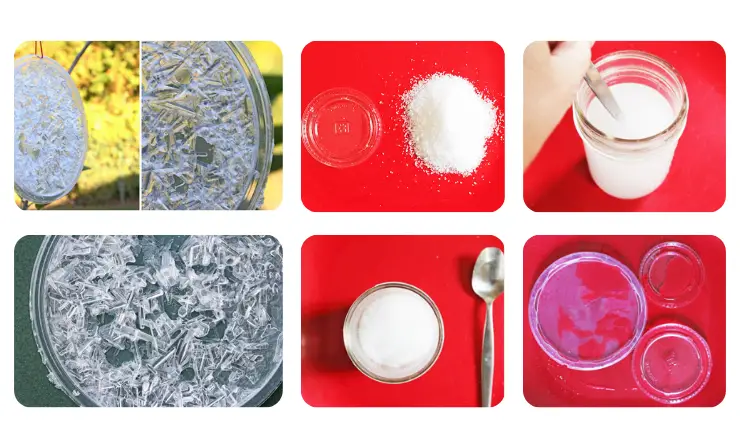
This science activity is adored by young minds, who find themselves mesmerized by its charm. The grocery store harbors the modest ingredients that bring forth a chorus of wonder and admiration from your students. However, be prepared for an extraordinary journey, as we skillfully transform these shimmering creations into splendid sun catchers, basking in the kaleidoscope of colors that dance in the sunlight.
For those who wish to take this experience to new heights, rest assured, as we merge art education into the spotlight. Within this realm, you will find links leading to an art icon whose masterpieces were inspired by the mesmerizing geometry akin to our enchanting crystals. This multi-dimensional journey intertwines creativity and imagination with the wonders of scientific discovery.
As your students embark on this wondrous adventure, they shall witness the magical fusion of art and science, illuminating the brilliance that arises from their convergence.
Learn to create mesmerizing crystal sun catchers in this STEM activity tutorial:
2. Jellybean Building
Materials: Jellybeans or large marshmallows, toothpicks, and a clear workspace.
Difficulty: Low
Cost: Low
What Does It Teach: Sparks creativity in structural engineering, promoting problem-solving and design skills.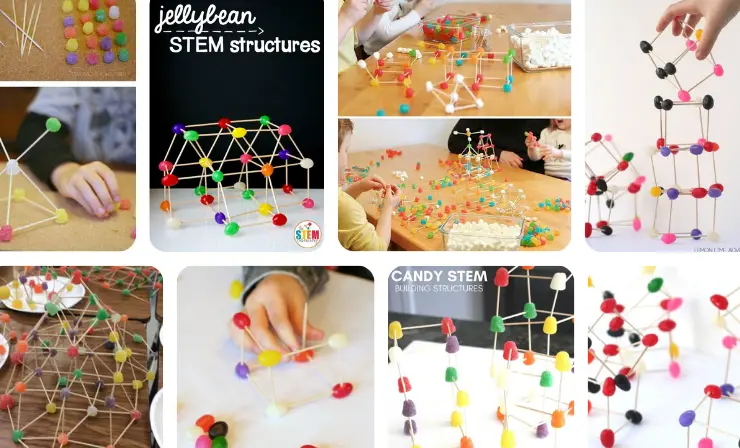
Welcome to the captivating world of structures, where a kaleidoscope of possibilities awaits your students or children. Using just a pile of jellybeans and toothpicks, embark on an exhilarating adventure in engineering. Encourage young explorers to weave a symphony of shapes by connecting toothpicks with jellybeans, as they uncover the structures with resolute strength, defy gravity with graceful finesse, and dazzle the eye with beguiling allure. This hands-on activity immerses them in the thought, design, and technology underlying the art of structural engineering.
As they traverse the labyrinth of possibilities, students witness the very essence of structural integrity unfold. They breathe life into their creative visions, conjuring houses and intricate structures from the depths of their imagination. Each connection becomes a contemplative dance of forces that hold their creations together, fostering an appreciation for the physics behind their architectural feats.
Throughout this engaging challenge, curiosity and ingenuity are sparked as students consider each option and make calculated decisions during their construction. The experience nurtures critical thinking and problem-solving skills, igniting a passion for exploring the principles of structural engineering.
Discover the art of constructing a jellybean building through this captivating video:
3. Pipe Cleaner Counting
Materials: Pipe cleaners, small pieces of paper, beads of different colors, and a clear workspace.
Difficulty: Low
Cost: Low
What Does It Teach: Provides a hands-on and visual approach to understanding counting and numerical progression.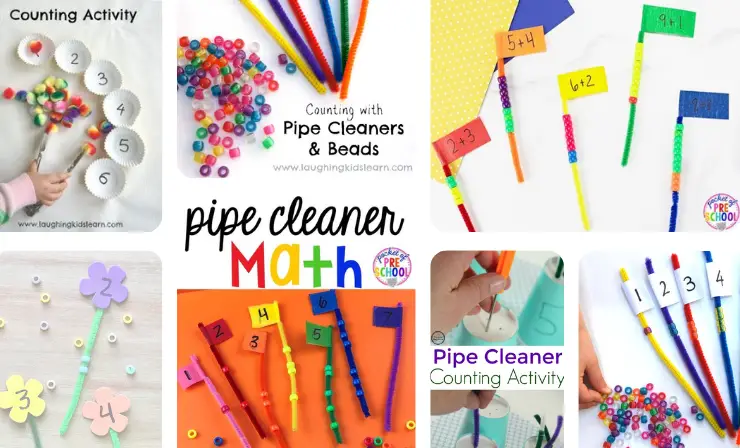
Understanding the concept of increasing numbers can be confusing for young students or children who are just learning to count. However, with the use of pipe cleaners and beads, you can assist them in grasping this concept while providing a visual aid.
Start by attaching small pieces of paper with numbers labeled on each pipe cleaner. Then, encourage the child to arrange the pipe cleaners from smallest to greatest and proceed to thread the appropriate number of beads onto them while counting aloud. This hands-on activity combines visual and auditory learning, making it an effective tool for enhancing their counting skills.
Engage young learners in counting with the creative use of pipe cleaners in this educational STEM demonstration:
4. Testing Air Resistance with Parachutes
Materials: Various materials for parachute construction (e.g., plastic bags, coffee filters, tissue paper), small objects (e.g., lightweight toys or figures), and a clear workspace.
Difficulty: Low
Cost: Low
What Does It Teach: Teaches how air resistance impacts the motion of objects in the air.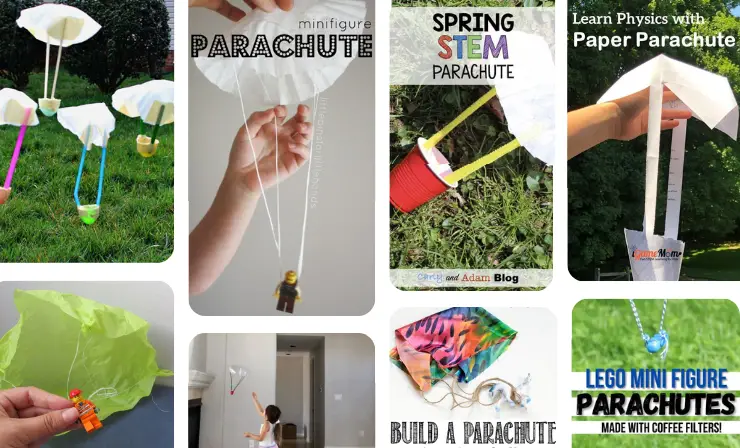
As students explore the scientific method to unravel the secrets of effective parachutes, the unfolding scene reveals their inner scientists at work. They design and test various materials to determine the champion of the skies. The mesmerizing process showcases each material gracefully defying gravity, exposing the intricacies of air resistance and shedding light on the physics behind this aerial spectacle.
The kaleidoscope of forces at play challenges their understanding of the world, and with each trial, curiosity deepens, and comprehension expands as they delve into the realm of scientific exploration. Observing, hypothesizing, experimenting, and concluding, their quest begins, paving the way for students to become pioneers of discovery, soaring through the vast expanse of knowledge with the help of parachutes and the scientific method.
Embracing the excitement of their scientific journey, students unravel the enigma of effective parachutes, forever altering their perspectives on the world around them. The fascination with science ascends to new heights, and they gain a profound appreciation for the intricate forces governing the laws of nature. Through this thrilling pursuit of knowledge, their understanding of air resistance soars, leaving them in awe of the mysteries that science unravels.
Learn how to explore the forces of air resistance with parachutes in this fascinating experiment:
5. Longest Paper Chain
Materials: A single piece of paper, scissors, and craft supplies (optional for decorating).
Difficulty: Low
Cost: Low
What Does It Teach: Promotes critical thinking, spatial reasoning, and problem-solving skills as students explore how to maximize the length of the paper chain within given constraints.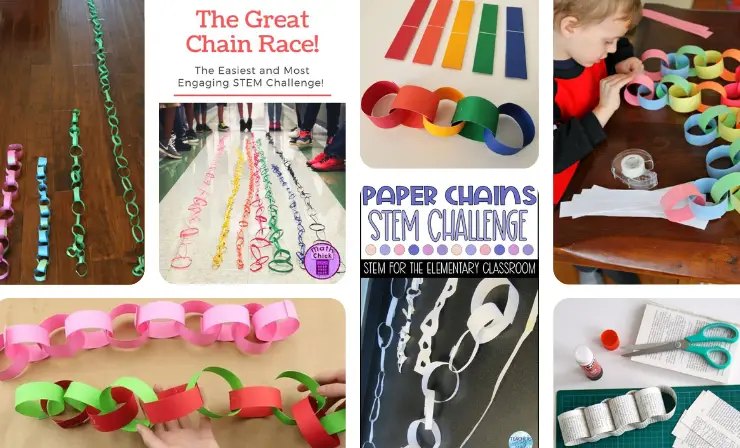
This quest challenges them to create the longest possible paper chain using just a single sheet of paper, unveiling a burst of excitement and ingenuity. While seemingly straightforward, it holds a world of creative possibilities, inviting sparks of ingenuity to fly as they conquer the paper chain conundrum. Each twist, fold, and link becomes a stroke of brilliance, unlocking the secrets of geometric connections.
With awe, observe their creations evolve, weaving a mesmerizing tapestry of complexity from the simplest of materials. Their imaginations demonstrate boundless potential, pushing the limits of what is achievable with a single sheet of paper. Through this seemingly unassuming endeavor, the essence of STEM learning takes root, inspiring the joy of problem-solving and critical thinking. As they unravel the intricacies of design, a sense of excitement fills the air, constructing a paper chain that defies expectations and stretches to unseen lengths.
Let the adventure commence as students embrace the challenge, encouraged to explore, experiment, and innovate. The quest for the longest paper chain becomes a gateway to a world of endless possibilities, nurturing their creativity and unleashing their potential for ingenious solutions.
Unleash creativity and problem-solving skills in the challenge showcased in this captivating video:
6. Cloud in a Jar
Materials: Glass jar with a lid, hairspray, ice cubes, hot water
Difficulty: Low to Medium (adjustable based on age and discussion complexity)
Cost: Low
What does it teach: Demonstrates condensation and the water cycle, encouraging curiosity about weather phenomena.
This delightful activity unveils the magic of cloud formation to young minds, taking them on a ride of wonder and discovery. Using everyday ingredients—water and hairspray—young learners witness the transformation of vapor into the ethereal beauty of clouds, grasping the intricate dance of molecules.
But the excitement doesn’t end there; this activity is a canvas of exploration that scales with the boundless curiosity of your students. For the littlest ones, simplicity reigns supreme, unlocking the mysteries of cloud formation with ease. Yet, for older kids, the experiment takes flight in a symphony of complexity, with two different methods converging to create clouds and inspiring conversations about the magnificent water cycles that shape our environment.
Witness their captivation as they unravel the interconnected web of nature’s cycles, where water weaves its way through the fabric of life. For bonus points, venture outdoors on a foggy or cloudy day, where the environment becomes the ultimate classroom, and this activity becomes a bridge between the wonders of science and the beauty of nature.
Let this delightful journey lead your young explorers through the boundless horizons of knowledge, connecting the dots between the minuscule water droplets that form clouds and the grand tapestry of our planet’s water cycles. Embrace the thrill of discovery as they unravel the mysteries of nature, nurturing a profound appreciation for the intricate processes that shape the world around them.
Learn how to create a cloud in a jar in this video:
7. Oil Spill
Materials: Large container, water, cooking oil, feathers, sponges, paper towels, little spoons, and a clear workspace.
Difficulty: Low to Medium (adjustable based on age and complexity of discussion)
Cost: Low
What Does It Teach: Raises awareness about the environmental impact of oil spills and the importance of conservation.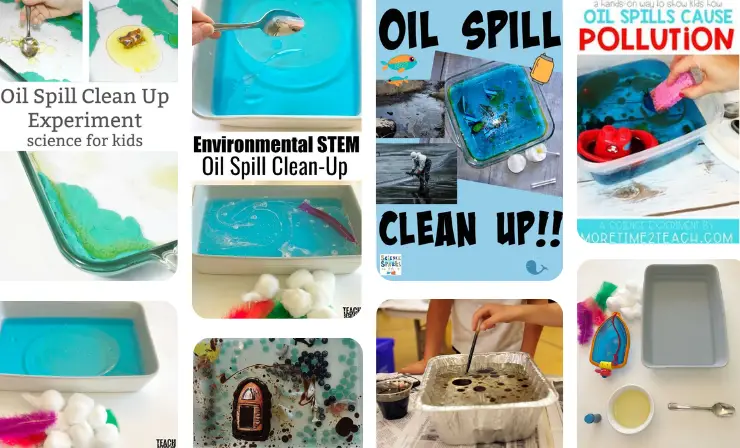
This mesmerizing experiment commences with a simple mixture of oil and water in a vast container, adorned with a few feathers. Observe young minds taking the lead, armed with sponges, paper towels, or tiny spoons, determined to remove the oil from the water and feathers. However, there’s a twist—encourage them to tread carefully, aiming to extract the oil without removing excessive water. Witness the awe-inspiring spectacle as they observe the oil’s effects on the delicate feathers and grapple with the challenges of its removal from the water.
Be astonished as this seemingly straightforward activity unveils profound insights into the real-world consequences of oil spills on the environment. Let them embrace the role of scientific investigators, piecing together the puzzle of this environmental conundrum and uncovering the intricate web of cause and effect.
And there’s more—this activity scales to the boundless heights of curiosity, accommodating learners of all ages. From the littlest explorers to older ones, the learning level adapts to their depths of understanding. However, bear in mind the potential messiness of oil, exercising discretion with younger learners.
Let this captivating experiment kindle a passion for environmental stewardship, empowering young minds to appreciate the delicate balance between nature and human actions. Embrace the opportunity to engage in meaningful conversations, where science intertwines with reality, fostering a generation of conscious caretakers of our precious planet. Through this immersive experience, students become catalysts for change, recognizing their role as protectors of the environment and advocates for a sustainable future.
Dive into the fascinating world of STEM with an oil spill activity in this educational video:
8. LEGO Maze Coding
Materials: LEGO bricks, LEGO minifigures, printed mazes, printed instruction cards (coding commands), and a clear workspace.
Difficulty: Low to Medium (adjustable based on age and coding experience)
Cost: Low
What Does It Teach: Teaches basics of coding and programming, computational thinking, robotics, and engineering concepts.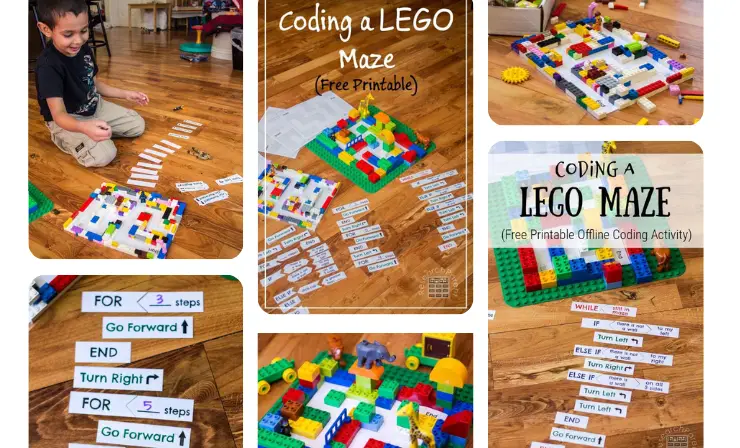
This activity is crafted to suit learners of all ages, from novices to seasoned explorers in elementary and even middle school. Explore the transformative power of coding with this activity from ResearchParent. Students don the mantle of the “user,” guiding their LEGO person through intricate mazes using the power of command codes. This journey accommodates all learning levels, with suggestions to scale down for younger kids or complicate it for older children. Engage their creativity with free printable materials, offering mazes and instruction cards that transform the LEGO person into a digital traveler.
As students align different codes, they embark on a path of sequence and looping, mastering the rudimentary foundations of coding for their future endeavors. Witness the thrill of discovery as they estimate the perspective of their LEGO companion, navigating through a virtual labyrinth of learning. This captivating activity becomes a gateway to a world of possibilities, where coding emerges as an art and science of creation, setting the stage for their coding journey ahead. Embrace the spark of inspiration within them as they bring the codes to life, forging a connection between their ideas and the digital realm. Let this immersive experience kindle their curiosity and passion for coding, empowering them to envision their future as creators, innovators, and pioneers of technology.
Discover the art of coding a LEGO maze in this fun and instructional video:
9. Hand Crank Winch
Materials: Cardboard, paper towel rolls, spool of ribbon or string, scissors, glue, markers, and a clear workspace.
Difficulty: Low to Medium (may require adult assistance for younger children)
Cost: Low
What Does It Teach: Explores simple machines and mechanical principles while engaging in hands-on construction.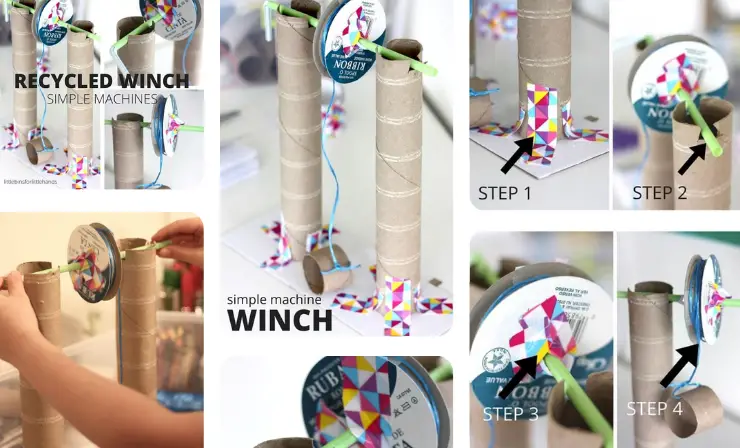
Students dive into this captivating project, igniting their imaginations with boundless possibilities of engineering. The creative construction awaits, utilizing tools like cardboard paper towel rolls and a spool of ribbon to bring the winch to life.
This hands-on experience sparks an early sense of building awesome things, where the principles of physics come alive in their tiny hands. The joy of discovery fills the air as they engage in this crafty endeavor, discovering the power of simple machines in their quest for knowledge. Guided by your assistance, they wield the tools of creativity, constructing the winch that fuels their understanding of the world.
Observe their sense of accomplishment soar, powered by their own ingenuity and resourcefulness. In this magical moment of exploration, the winch becomes a symbol of their limitless potential—a testament to the wonders they can create with imagination and innovation. Let this captivating journey ignite their passion for discovery, inspiring a generation of curious minds to embrace the art of building and the marvels of engineering.
Explore the wonders of engineering as you build a hand crank winch in this creative video:
10. Balance Scale
Materials: Plastic hanger, two small cups, string or yarn, small objects of various weights (e.g., LEGOs, toy cars, beads), and a clear workspace.
Difficulty: Low to Medium (may require adult assistance for younger children)
Cost: Low
What Does It Teach: Encourages experimentation with weights and measurements, fostering critical thinking.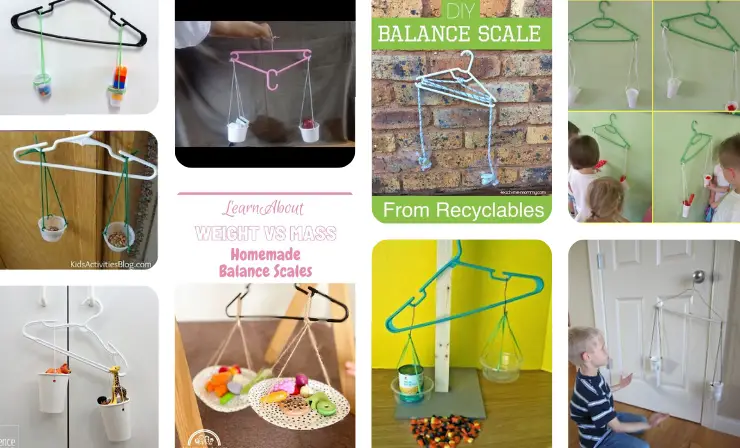
An engaging activity awaits, involving a plastic hanger, cups, and string—a concoction that creates a hanging balance, inviting young minds to experiment with weights. For older children, enlisting their help in building the scale enhances the thrill of discovery.
Encourage their sense of experimentation with intriguing questions, such as “How many LEGOs does this toy car weigh?” Hands On As We Grow suggests adding variety by sorting items by shapes, materials, and more. This homemade scale evolves into a captivating STEM project, enticing them to return to it repeatedly, unearthing new wonders with each exploration. Let this hanging balance be a beacon of curiosity, propelling them on a journey of scientific inquiry, where the joy of discovery knows no bounds.
Through this activity, they become explorers, charting their course through the vast terrain of STEM learning with excitement and wonder. As they unravel the mysteries of balance and measurement, the homemade scale becomes a symbol of their newfound understanding and the gateway to a world of scientific exploration that calls them back time and time again.
Learn the principles of balance and measurement with a video tutorial on building a balance scale:
11. Stop-Motion Animation Video
Materials: Objects for animation (e.g., toys, clay figures, art supplies), a smartphone or iPad with a stop-motion app, and a clear workspace.
Difficulty: Low to Medium (may require adult assistance for younger children)
Cost: Low
What Does It Teach: Offers a creative and technologically engaging activity to explore animation and movie-making, fostering storytelling and technology utilization.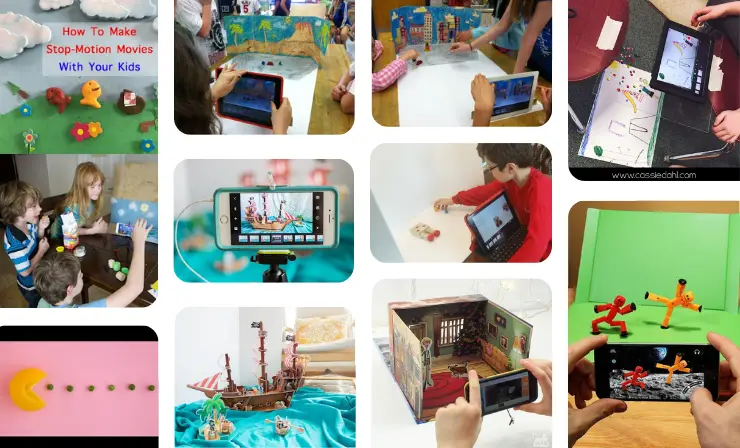
This activity presents an excellent option for creative STEM learning. Stop-motion videos have captivated us online, but have you ever considered creating one yourself or, better yet, with your kids? It’s a thrilling adventure that requires only a few objects, a smartphone or iPad, and a stop-motion app. Through this process, your kids will delve into the technology behind movie-making and craft a video that is truly their own, infused with their unique likes and interests. Watch in awe as their creativity comes to life, and they unravel the artistry behind animation and storytelling.
This hands-on activity paves the way for endless possibilities, encouraging them to explore the world of visual storytelling and embrace their role as creators and directors of their own cinematic masterpieces. As they immerse themselves in the realm of stop-motion, they become the architects of their stories, breathing life into inanimate objects and unleashing the power of imagination.
Unleash your creativity in stop-motion animation with this engaging video guide:
12. Drinking Straw Roller Coaster
Materials: Drinking straws, tape, scissors, small objects (e.g., marbles or small balls), and a clear workspace.
Difficulty: Low to Medium
Cost: Low
What Does It Teach: Teaches engineering principles, including structural stability and the dynamics of motion.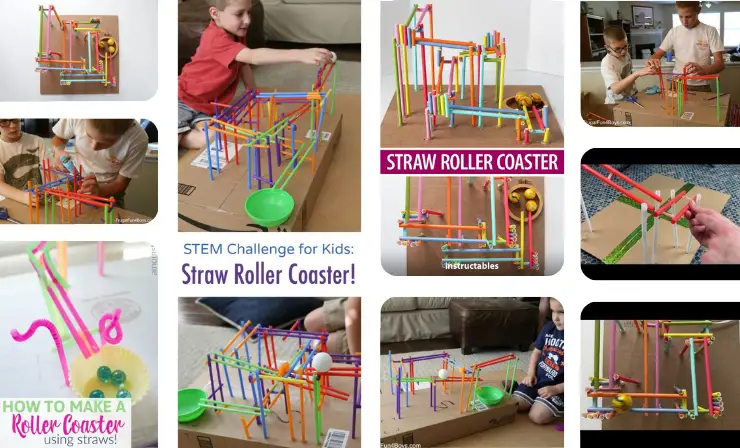
A fun and exciting way to foster engineering skills awaits! All you need are simple supplies like drinking straws, tape, and scissors. With these tools, young learners can embark on a journey of creativity and problem-solving, as they engage in hands-on engineering challenges. Watch in delight as they construct and design, utilizing the basic materials to build intricate structures and innovative solutions.
This activity becomes a gateway to the world of engineering, igniting their passion for exploration and empowering them to tackle real-world problems with ingenuity and resourcefulness.
Through the process of building with drinking straws, they become architects of their own creations, discovering the principles of engineering and discovering the boundless potential of their ideas.
Experience the thrill of a straw roller coaster project in this hands-on video:
13. Marble Maze
Materials: Straws, paper plates, cardboard tubes, craft supplies, marbles, and a clear workspace.
Difficulty: Low to Medium
Cost: Low to Medium
What Does It Teach: Encourages creativity, critical thinking, and understanding of physics concepts like gravity, friction, and motion.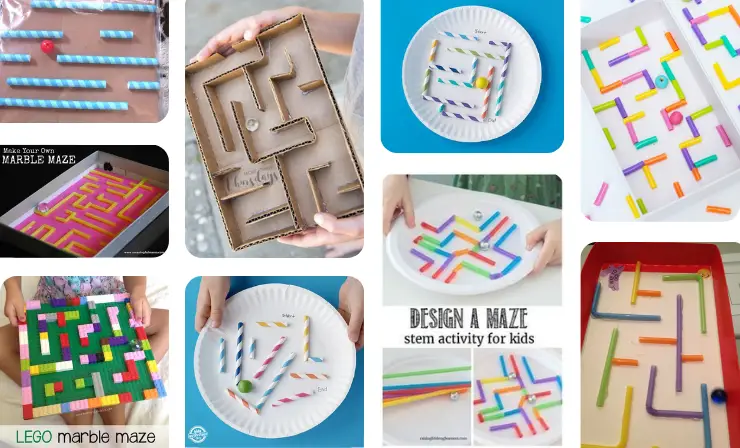
Marble mazes stand as a beloved STEM activity among students! The possibilities are endless as they dive into this captivating endeavor. Whether you provide supplies like straws and paper plates or simply let their imaginations soar, young minds become architects of their own marble mazes. Watch in awe as they design intricate pathways and experiment with the laws of physics to guide marbles through their creations.
This activity becomes a celebration of creativity and innovation, as they explore a myriad of materials to construct mazes that defy expectations. The journey into marble mazes empowers them to think critically, solve problems, and embrace the joy of hands-on learning. As they witness the marvels of their creations in action, they become masters of their own design, unraveling the art and science behind mazes with excitement and ingenuity.
Build a captivating marble maze with this step-by-step video tutorial:
14. Magnetic Slime
Materials: White school glue, iron oxide powder, liquid starch, magnets.
Difficulty: Medium
Cost: Low
What Does It Teach: Introduces magnetism and properties of polymers through a fun, hands-on experiment.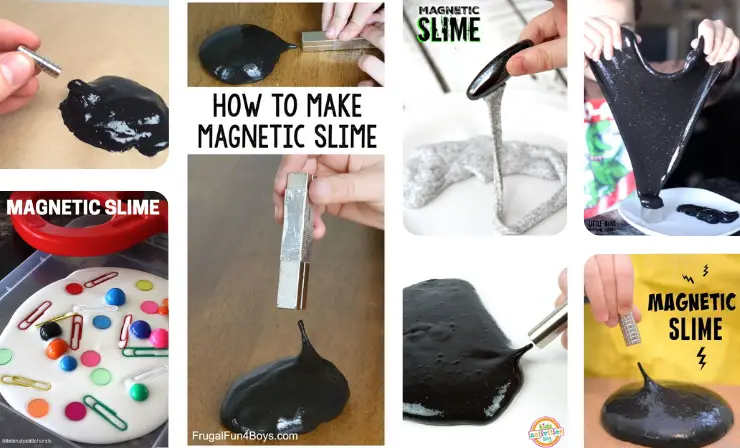
Creating homemade “slime” has become a beloved tactile activity for parents and educators alike. This variant, with a science twist, introduces iron oxide powder and magnets into the mix. Achieving the perfect slime consistency may pose a slight challenge, but adding more glue or liquid starch can resolve most issues. Once the starch is ready, a strong neodymium magnet (or more) becomes the key to manipulating the slime.
Beyond the fun, this activity sparks engaging conversations, as kids are bound to have plenty of questions about how magnets work. Prepare yourself by brushing up on the subject before diving in, and watch in delight as their curiosity unfolds. Through this playful yet educational adventure, young minds explore the world of science and the magic of magnets, all while reveling in the joy of hands-on discovery.
Delve into the science of magnetism with a fascinating video on creating magnetic slime:
15. Solar Oven Project
Materials: Pizza box, aluminum foil, plastic wrap, black construction paper.
Difficulty: Medium
Cost: Low
What Does It Teach: Demonstrates solar energy principles and sustainable cooking methods.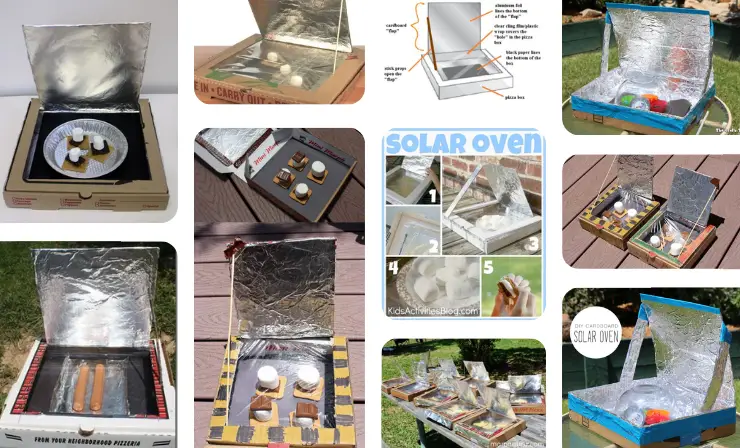
As young minds engage in this eco-friendly journey, they embrace the power of renewable energy and its positive impact on the environment, becoming advocates for a greener future. Through this immersive activity, they gain a deeper appreciation for science and the role of sustainable practices in shaping a brighter world.
Let this solar-powered cooking adventure ignite their passion for renewable energy, inspiring a generation of eco-conscious individuals. As they savor the fruits of their solar-powered labor, the value of solar energy becomes a beacon of hope, empowering them to become guardians of the environment. In this captivating exploration, the wonders of solar energy pave the way for a more sustainable and prosperous future.
Learn about harnessing solar energy with a video guide on building a solar oven:
16. Egg Drop Challenge
Materials: Eggs, various materials like straws, cardboard, tape, and cotton balls.
Difficulty: Medium
Cost: Low
What Does It Teach: Teaches engineering and problem-solving skills as students design protective containers for eggs.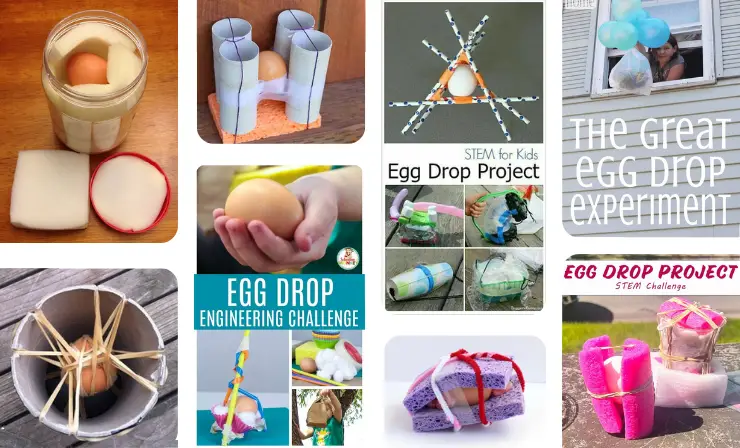
Participating in this classic STEM activity is an essential and enjoyable experience for every child. Its versatility allows kids of all ages to engage, and they can mix things up by using different materials and heights for added excitement.
Whether they’re little explorers just beginning their journey or seasoned adventurers, this activity promises a world of hands-on learning and discovery. As they delve into the captivating world of STEM, their creativity blossoms, and their minds light up with wonder and curiosity. It’s an opportunity to foster a lifelong passion for exploration and knowledge, nurturing their innate curiosity and empowering them to be inquisitive learners.
So, encourage them to dive into this timeless endeavor, where the wonders of science, technology, engineering, and mathematics intertwine, igniting their imagination and encouraging critical thinking. Through this simple yet profound experience, they become architects of their own learning, and the seeds of curiosity planted in this classic STEM activity flourish into a lifetime of exploration and innovation.
Embark on an egg drop challenge in this exciting video, testing the limits of engineering and physics:
17. Balloon-Powered Car
Materials: Balloons, bottle caps, cardboard, straws, bottle, tape.
Difficulty: Medium
Cost: Low
What Does It Teach: Teaches the principles of motion and propulsion, introducing concepts like Newton’s third law of motion.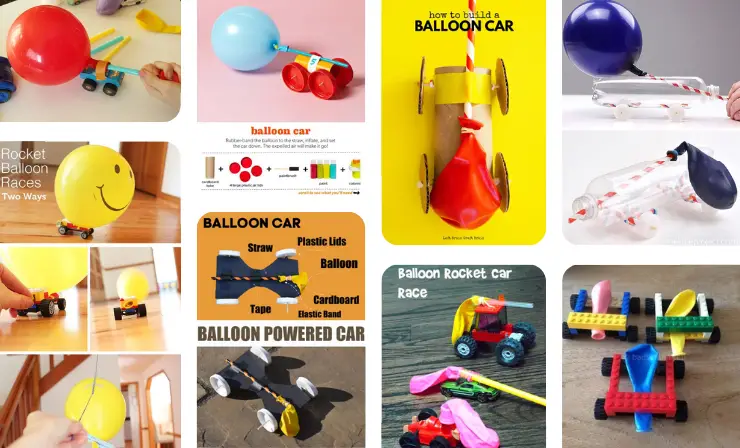
This hands-on activity unleashes their ingenuity as they combine scientific principles with imaginative engineering. Embrace the eco-friendly bonus by encouraging them to use only recycled materials, making this project a green endeavor that instills a sense of environmental responsibility.
Through this exciting venture, young minds become scientists and innovators, unraveling the mysteries of motion and propulsion. As they design and construct their balloon-powered cars, they delve into the physics behind movement, gaining a deeper understanding of forces, friction, and energy. Witness their enthusiasm as they test their creations, unleashing the power of air and propulsion with each balloon-filled breath. This activity becomes a window to creativity and innovation, igniting their passion for STEM and inspiring a generation of eco-conscious problem-solvers.
Design, build, and race your own balloon-powered car in this exhilarating video activity:
18. Steady-Hand Game
Materials: Cardboard, wires, LEDs, a buzzer, aluminum foil, craft supplies, batteries, and a clear workspace.
Difficulty: Medium
Cost: Low to Medium
What Does It Teach: Introduces students to circuitry and electrical components while honing their fine motor skills and problem-solving abilities.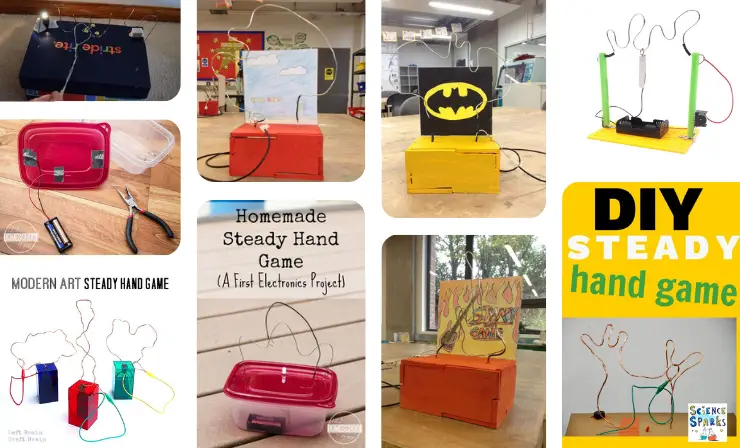
The steady-hand game stands as a delightfully fun and educational activity that delves into the realm of circuits. It seamlessly incorporates the “A” of STEAM, infusing creativity into the learning experience. Through this interactive adventure, young learners become engrossed in the world of electronics and the magic of circuits.
As they engage in the creation of the steady-hand game, they unravel the principles of circuitry, exploring the flow of electricity and the intricacies of conductors and insulators. Their creativity blossoms as they design and construct the game, infusing their personal touch to make it uniquely their own. Witness their excitement as they test their steady hand, navigating the circuit’s pathways without triggering the buzzer. This hands-on learning experience becomes a gateway to understanding the synergy between science, technology, engineering, art, and mathematics.
Engage in a steady-hand game to explore circuits and creativity in this captivating video:
19. Helping Hand
Materials: Craft materials (e.g., cardboard, straws, rubber bands, popsicle sticks), scissors, glue, markers, and a clear workspace.
Difficulty: Medium to High (may require guidance from educators or parents)
Cost: Low
What Does It Teach: Inspires critical thinking and problem-solving while exploring biomechanics and engineering in creating a functional hand model.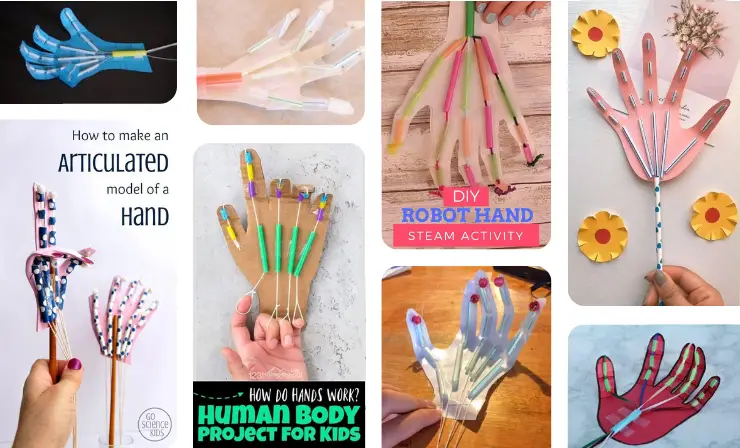
The “Helping Hand” activity emerges as a fantastic group science project, igniting the spark of curiosity and honing the students’ design and engineering prowess. In this captivating endeavor, they set out to create a functional model of a hand, unraveling the mysteries of human anatomy and engineering.
As they delve into this hands-on exploration, young minds become scientific investigators, dissecting the intricacies of the human hand and translating them into a working model. The activity fosters collaboration and teamwork, allowing students to pool their ideas and skills to bring the project to life. Witness their ingenuity as they embrace the challenge of mimicking the complexity and versatility of a human hand, reflecting the essence of STEAM education. This activity becomes a conduit for understanding the interplay between biology and engineering, where the wonders of science converge with the power of innovation.
Join an inspiring project as you build a helping hand model in this hands-on video tutorial:
Useful Resources
Conclusion
Congratulations! You’re now equipped with simple and budget-friendly STEM activities for your kids. Watch in awe as young minds explore the thrilling world of science, technology, engineering, and math. And don’t forget, there are endless age-appropriate ideas out there. Embrace early childhood development and let your imagination create unique STEM adventures for your curious learners. Together, you’ll embark on a journey of discovery, fueling your passion for learning and embracing a future full of possibilities. The wonders of STEM await!
